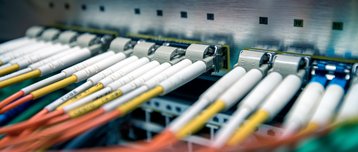Cables stand out in any data center, whether they’re in tidy bundles or crazy jumbles. For folks who love cables, there’s a CablePorn subreddit, dedicated to pictures of the tidiest racks, while the haters can tut-tut over photos of how things can go wrong.
Any sensible data center person will see cables as necessary and useful. They aren’t an end in themselves, but you need to get them right - and as technology develops, new ways to do this will emerge. Last year, we heard quite a lot at DatacenterDynamics about how copper cabling would persist in data centers, even as they upgrade to 100Gbps. However, whatever the copper supporters say, fiber is arriving in the data center.
Copper won’t cut it
As data speeds increased towards 40Gbps, data centers started to adopt fiber. Even though copper can carry high speeds, the distances are shorter, and if you stuck with copper you needed the solutions tend to use multiple copper cables. That gives great opportunities for installing pretty bundles, but there’s more to life than getting kudos in the CablePorn subreddit.
So, we move to fiber, but the trouble is, what kind? The really good stuff is rated for long distances (10km or more) and used in telecoms networks - and it is expensive. Datacenters are built to a budget and have much shorter distances, so they use cheaper cables, which has generally meant lower quality.
Multimode fiber has a thick core, and carries light on multiple paths. It is cheaper to buy, install and terminate, but has poorer performance. Single mode, used in telecoms, is thinner, and only allows one mode of light propagation, so there is less distortion.
For a long while, data centers have put in multimode fiber, but now speeds are increasing again, with 100Gbps on the cards. This can be done with mulimode fiber, but solutions tend to use multiple fibers, and we’re back with bundles.
In-building traffic boom
At this point, the big users started to talk to the cable makers. Traffic between servers within a data center can be bigger than that between them - and a 360-degree video filmed in a Google data center recently made the point that traffic within that site was greater than the traffic across the public Internet.
Facebook uses tens of thousands of kilometers of fiber within its data centers - so it spoke to cable manufacturers and asked for single-mode fibers to run 100Gbps within the data center. Cable makers responded with cables made to lower specifications, rated for 500m, and at the Open Compute Project (OCP) Summit earlier this month, these were shared with the community.
Only two fibers are needed for 100Gbps, so there is less clutter. What’s more, unlike previous generations, these might last. You need to be wary of any promise that cables are future-proof, but once you have single mode fiber, you can increase the throughput by upgrading your switches with better opto-electronics, so these fibers can add more colors to their transmission (wave division multiplexing), and might go to Terabits.
Fewer cables means better airflow so cooling can improve. And if the cables have a longer life, then the facility creates less waste over its lifetime. Greener all round.
A version of this article appeared in Green Data Center News
If you are interested in learning more about data center cabling systems register now to our next webinar.



